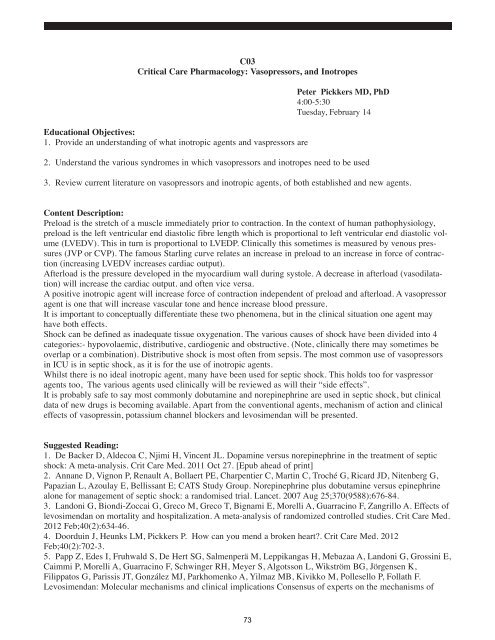ABSTRACTS from 16th International COnference on ... - CRRT Online
ABSTRACTS from 16th International COnference on ... - CRRT Online
ABSTRACTS from 16th International COnference on ... - CRRT Online
You also want an ePaper? Increase the reach of your titles
YUMPU automatically turns print PDFs into web optimized ePapers that Google loves.
C03<br />
Critical Care Pharmacology: Vasopressors, and Inotropes<br />
Educati<strong>on</strong>al Objectives:<br />
1. Provide an understanding of what inotropic agents and vaspressors are<br />
Peter Pickkers MD, PhD<br />
4:00-5:30<br />
Tuesday, February 14<br />
2. Understand the various syndromes in which vasopressors and inotropes need to be used<br />
3. Review current literature <strong>on</strong> vasopressors and inotropic agents, of both established and new agents.<br />
C<strong>on</strong>tent Descripti<strong>on</strong>:<br />
Preload is the stretch of a muscle immediately prior to c<strong>on</strong>tracti<strong>on</strong>. In the c<strong>on</strong>text of human pathophysiology,<br />
preload is the left ventricular end diastolic fibre length which is proporti<strong>on</strong>al to left ventricular end diastolic volume<br />
(LVEDV). This in turn is proporti<strong>on</strong>al to LVEDP. Clinically this sometimes is measured by venous pressures<br />
(JVP or CVP). The famous Starling curve relates an increase in preload to an increase in force of c<strong>on</strong>tracti<strong>on</strong><br />
(increasing LVEDV increases cardiac output).<br />
Afterload is the pressure developed in the myocardium wall during systole. A decrease in afterload (vasodilatati<strong>on</strong>)<br />
will increase the cardiac output. and often vice versa.<br />
A positive inotropic agent will increase force of c<strong>on</strong>tracti<strong>on</strong> independent of preload and afterload. A vasopressor<br />
agent is <strong>on</strong>e that will increase vascular t<strong>on</strong>e and hence increase blood pressure.<br />
It is important to c<strong>on</strong>ceptually differentiate these two phenomena, but in the clinical situati<strong>on</strong> <strong>on</strong>e agent may<br />
have both effects.<br />
Shock can be defined as inadequate tissue oxygenati<strong>on</strong>. The various causes of shock have been divided into 4<br />
categories:- hypovolaemic, distributive, cardiogenic and obstructive. (Note, clinically there may sometimes be<br />
overlap or a combinati<strong>on</strong>). Distributive shock is most often <str<strong>on</strong>g>from</str<strong>on</strong>g> sepsis. The most comm<strong>on</strong> use of vasopressors<br />
in ICU is in septic shock, as it is for the use of inotropic agents.<br />
Whilst there is no ideal inotropic agent, many have been used for septic shock. This holds too for vaspressor<br />
agents too, The various agents used clinically will be reviewed as will their “side effects”.<br />
It is probably safe to say most comm<strong>on</strong>ly dobutamine and norepinephrine are used in septic shock, but clinical<br />
data of new drugs is becoming available. Apart <str<strong>on</strong>g>from</str<strong>on</strong>g> the c<strong>on</strong>venti<strong>on</strong>al agents, mechanism of acti<strong>on</strong> and clinical<br />
effects of vasopressin, potassium channel blockers and levosimendan will be presented.<br />
Suggested Reading:<br />
1. De Backer D, Aldecoa C, Njimi H, Vincent JL. Dopamine versus norepinephrine in the treatment of septic<br />
shock: A meta-analysis. Crit Care Med. 2011 Oct 27. [Epub ahead of print]<br />
2. Annane D, Vign<strong>on</strong> P, Renault A, Bollaert PE, Charpentier C, Martin C, Troché G, Ricard JD, Nitenberg G,<br />
Papazian L, Azoulay E, Bellissant E; CATS Study Group. Norepinephrine plus dobutamine versus epinephrine<br />
al<strong>on</strong>e for management of septic shock: a randomised trial. Lancet. 2007 Aug 25;370(9588):676-84.<br />
3. Land<strong>on</strong>i G, Bi<strong>on</strong>di-Zoccai G, Greco M, Greco T, Bignami E, Morelli A, Guarracino F, Zangrillo A. Effects of<br />
levosimendan <strong>on</strong> mortality and hospitalizati<strong>on</strong>. A meta-analysis of randomized c<strong>on</strong>trolled studies. Crit Care Med.<br />
2012 Feb;40(2):634-46.<br />
4. Doorduin J, Heunks LM, Pickkers P. How can you mend a broken heart?. Crit Care Med. 2012<br />
Feb;40(2):702-3.<br />
5. Papp Z, Edes I, Fruhwald S, De Hert SG, Salmenperä M, Leppikangas H, Mebazaa A, Land<strong>on</strong>i G, Grossini E,<br />
Caimmi P, Morelli A, Guarracino F, Schwinger RH, Meyer S, Algotss<strong>on</strong> L, Wikström BG, Jörgensen K,<br />
Filippatos G, Parissis JT, G<strong>on</strong>zález MJ, Parkhomenko A, Yilmaz MB, Kivikko M, Pollesello P, Follath F.<br />
Levosimendan: Molecular mechanisms and clinical implicati<strong>on</strong>s C<strong>on</strong>sensus of experts <strong>on</strong> the mechanisms of<br />
73
















